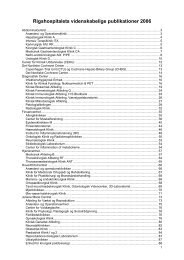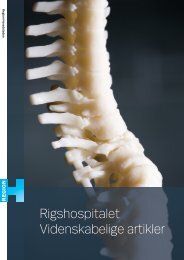View - CTU
View - CTU
View - CTU
Create successful ePaper yourself
Turn your PDF publications into a flip-book with our unique Google optimized e-Paper software.
:mt or treat apical<br />
Jmplicated, such<br />
)duce successful<br />
9eth (Kerekes &<br />
the other hand,<br />
oot filling quality<br />
In Denmark, for<br />
~d teeth showed<br />
hermore, 52% of<br />
)bviously there is<br />
I with root canal<br />
the starting point<br />
>rs that influence<br />
actice.<br />
therefore it might<br />
:, the demand for<br />
k of knowledge<br />
orary reasons for<br />
ern strategies for<br />
general dental<br />
reatment (Study<br />
mtal practice are<br />
the knowledge,<br />
9 patient, framed<br />
tion systems and<br />
Some of these factors were approached in the present series of studies. Recent<br />
years have seen a technological breakthrough within the field of root canal treatment.<br />
For example, it has been suggested that the adoption of new technology such as<br />
nickel-titanium rotary instruments will facilitate negotiation of the root canal system<br />
and make practitioners more often produce high quality root canal treatments (Study<br />
IV). Studies have pointed out various biological and technical factors that are<br />
important for the outcome of endodontic therapy. However, to what extent this<br />
knowledge is appreciated and correctly used by GDPs is not well understood (Study<br />
V) and neither is their confidence in performing root canal treatments (Study II). The<br />
final part of the present dissertation addresses the interaction between the dentist<br />
and the patient from an ethical and communicative point of view. It was assumed<br />
that important aspects of this interaction could be revealed by studying malpractice<br />
cases (Study VI).<br />
1.--<br />
The annual<br />
frequency of<br />
root fillings<br />
VI.<br />
Patient<br />
dissatisfaction<br />
Lay-out of the dissertation<br />
II.<br />
Reasons for root<br />
canal treatment<br />
Context:<br />
Danish National Health Insurance<br />
Remuneration system<br />
II, V.<br />
Knowledge and<br />
attitudes about<br />
endodontics<br />
Ill.<br />
Prevention of root<br />
canal treatment<br />
IV.<br />
New technology<br />
Fig. 1. In the interaction between the patient and the dentist the goal is to obtain the best treatment<br />
result. Within this context, the present dissertation has selected some factors (I-VI) which may<br />
determine the quality of root canal treatments and pulp-preserving procedures.<br />
9








